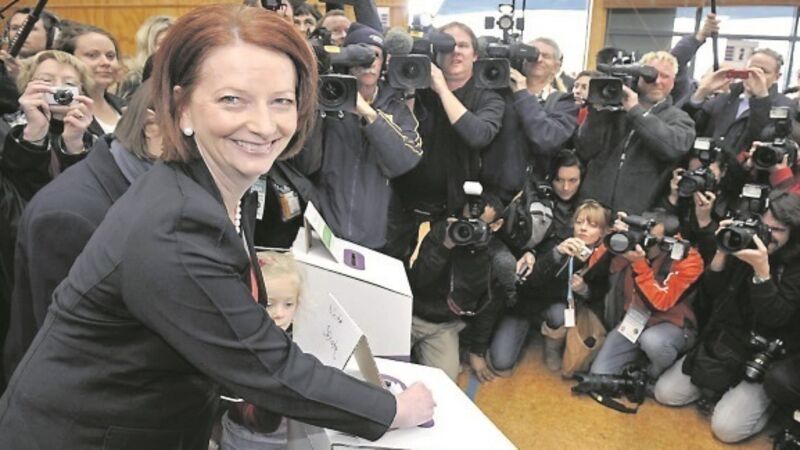Media glare has always been on female politicians’ appearances

O the young Meath county councillor is out canvassing. Because she’s not a Government candidate in the next election, she doesn’t get criticisms of Government actions thrown at her on the doorsteps of her constituency. Instead, she gets friendly advice. Like, maybe she could smarten up. Indeed, she might wear a bit more make up. The old mascara and eye shadow would, by implication, make her more acceptable as a candidate. Never mind all that policy stuff, it’s appearance that really counts.
The candidate involved did the smart thing. She went public about the advice and got a lot of good publicity arising therefrom, which will raise her name-recognition when it comes to polling day. Fair dues.
Now, the publicity happened in a week when mainstream media presented women mainly as glamour figures attending various race meetings. The women involved happily participated in contests to decide which of them was the best-dressed, and we got delightful details about how some of them crafted the dresses all by their little selves. Plus we got fascinators. Right, left, and centre, we got fascinators.
I’m up to here with fascinators. I’m so done with fascinators. Admittedly, banning hats was one of the rules I made for myself as a teenager, along with promising that, when I was my own woman, I was never, ever, as long as I lived, going to eat either cabbage or porridge. The hat hatred derived from the Breton sailor inflicted on me by my mother for my confirmation.
My mother had a sadistic genius for putting her daughters in headgear that made them look their worst. The yoke she put on my sister’s head for her Holy Communion gave her the fetching appearance you’d expect if she’d had a fight with a feather pillow and lost. The Breton sailor was just as bad. I had a teenage moon face to start with, and the hat surrounded and underlined the mooniness of my visage. I hated it with a passion, and extrapolated the way Mark Twain said cats do. He pointed out that if a cat sits on a hot stove, it’ll never sit on a hot stove again. But it will never sit on a cold stove, either. Same thing with the Breton sailor. One hat bad, all hats bad. From that day to this, no hat has ever graced my head, although I did once flirt with a white fedora.
So I have never been endangered, personally, by a fascinator. Vile symbols of fashion subservience, they are. The feminists who burned a barrel of bras back in the day had no notion that the bra would be succeeded, as a badge of ‘femininity’ by the bloody fascinator. I’m up for a fascinator burning any time someone has a handy number of them for incineration.
The more serious point is that it’s difficult to maintain full-bore outrage about the female politician being told off about her appearance in a season when the wider context is sodden with the concept of women being acceptable only if she is glammed to the gills.
And that’s ordinary women. Female politicians are subjected to much worse, and always have been. It was acceptable to describe one now retired female politician as a sumo wrestler, and it’s acceptable to ignore everything a female politician from a later generation says on the Late, Late Show if the opportunity is there to go viral about her green dress.
The former Socialist prime minister of Australia, Julia Gillard, was damned by gender-skewed media coverage, any single example of which, as she pointed out in her autobiography, My Story, sounds trivial.
“There’s the television footage taken from behind of me getting into a car, the lens trained on my bottom, not something done to male prime ministers,” she points out. “Even before Germaine Greer’s attention-seeking outburst about my body shape and clothing, apparently my arse was newsworthy.”
Germaine Greer’s “attention-seeking outburst” happened on one of those all-women TV programmes where issues significant to the gender are discussed. Greer criticised Gillard’s wardrobe, announcing to the viewers that the prime minister had “a big arse” and needed to manage it by dressing better. This criticism, mark you, came from a world-famous feminist academic and author, who was quite happy to participate in the reduction of her home country’s head of government to a stereotype.
The fact is that this stereotype has a long track record. When Harvard Business School did an experiment where the story of achievement by a businessperson was given to students to read, they led half the students to believe the businessperson was a woman, while the other half were told the businessperson was a man. The students found the male likable. They found the female unlikable: She was, they decided, selfish. Nor should you believe this viewpoint was held only by the male students. The conclusion was reached by male and female students alike: Equal opportunity stereotypers, they were.
The few women who have, in Ireland, reached leadership or cabinet level in Irish politics have experienced more than their fair share of this sort of thing. I was present when a new minister, having official photographs taken, was “humourously” asked by the photographer to relax for a minute while he changed to a wide angle lens that could accommodate her bustline.
We have all seen coverage of female politicians who have lost weight, said coverage cast as if, slimmed-down, they were now acceptable and much more valid. Every time a politician of the female persuasion appears on TV, Twitter comes alive with comments about her hair, her weight, or her outfit.
It’s always assumed, because I work with politicians, that I advise the women on what to wear, although, oddly, in the last decade, it’s mostly the men who’ve asked wardrobe questions. This, despite them having a safe basic uniform which allows viewers of a TV programme to register, in milliseconds, that they have the clean shirt, the acceptable suit and a tie without a nude down the length of it, and get on with listening to what they have to say.
Women have no such uniform. Experienced female canvassers, however, rarely think about make-up. They think about shoes that allow them to walk several kilometres at a time, up and down the driveways of houses that may or may not be occupied. They think about anoraks that won’t roast them if the weather is fine but will keep them dry if it isn’t. They don’t expect to have men advising them on lipstick and foundation.
Anyone advising a female politician on appearing on TV or going canvassing should concentrate on making sure they don’t wear anything that’s louder than they are: something that would vividly distract from the content they need to deliver on media or the relationship they seek to build at a constituent’s front door. Obsessing about a stereotype is not useful.
Or, as one extremely successful female politician put it when told about the new candidate getting it in the neck about lack of make-up: “That’s the WORST that was said to her? She’s lucky.”














